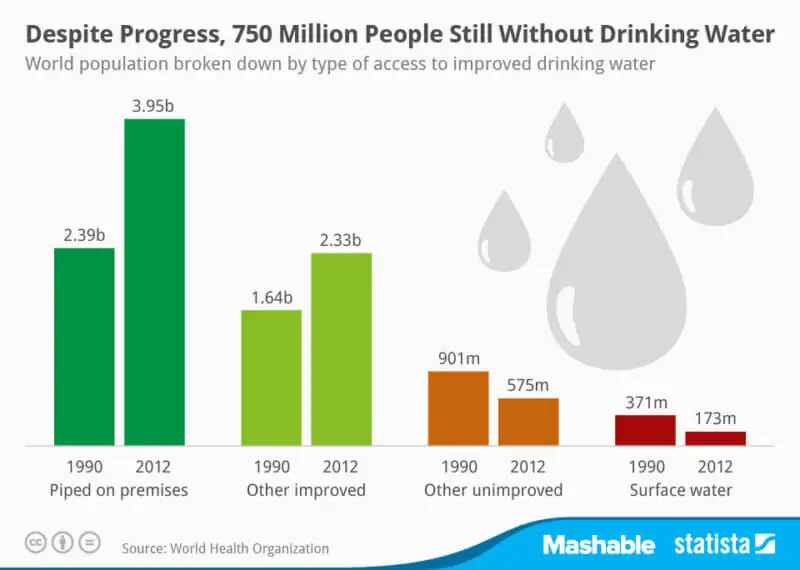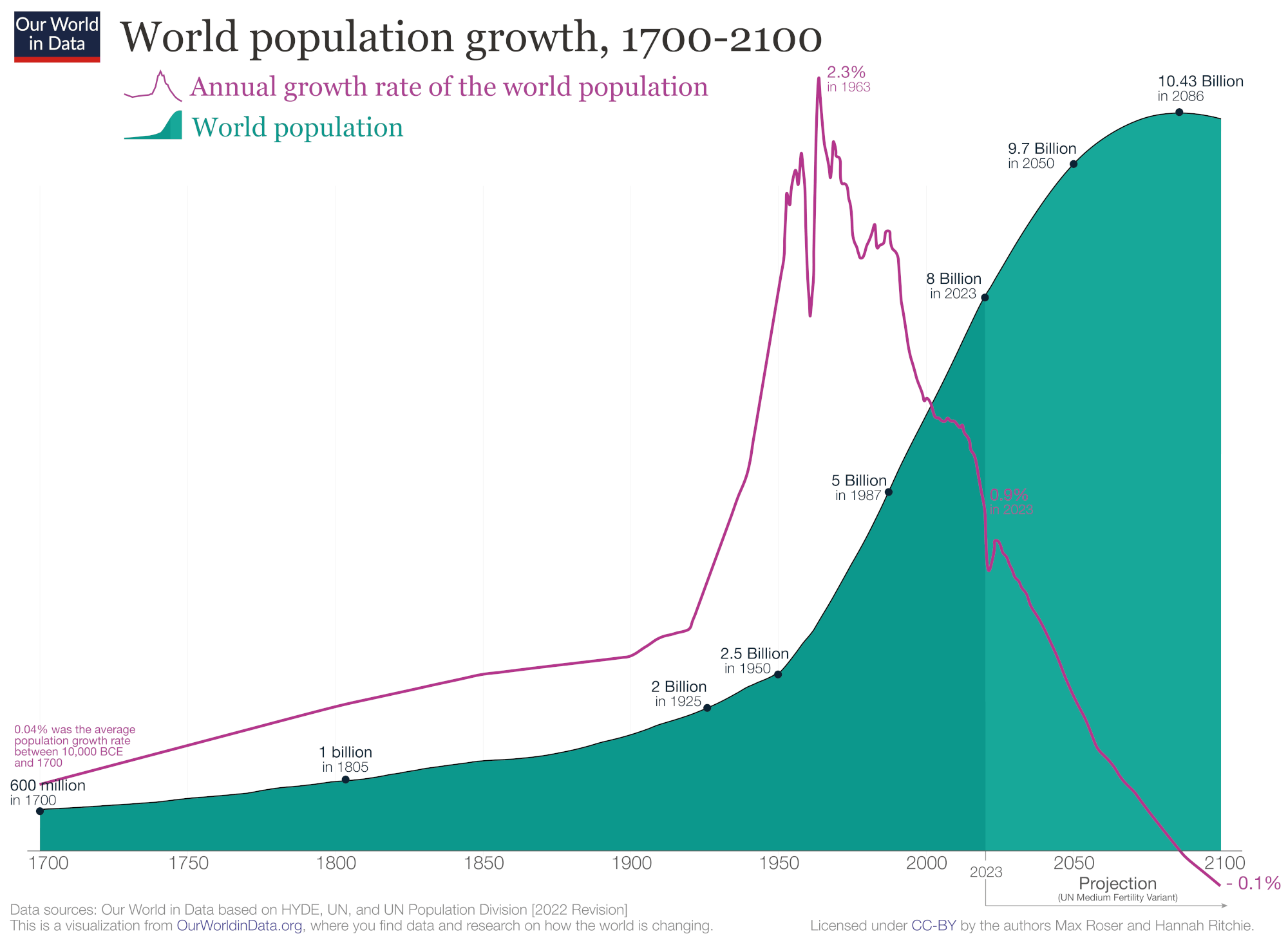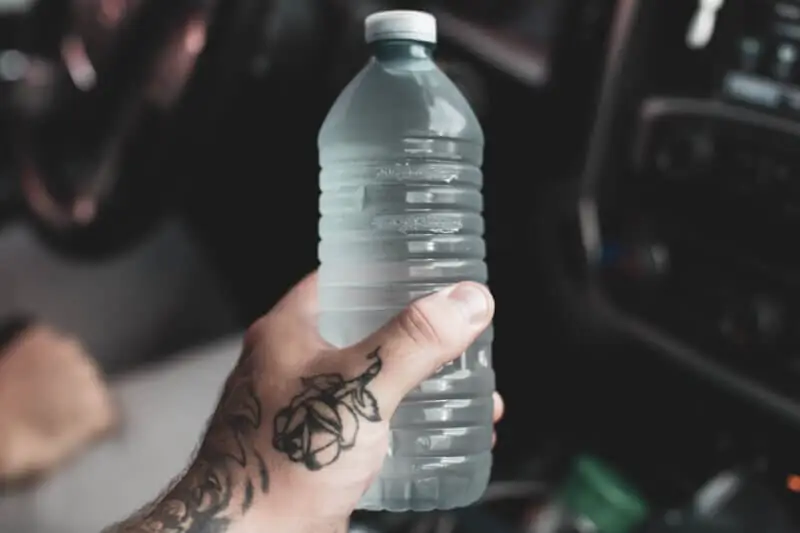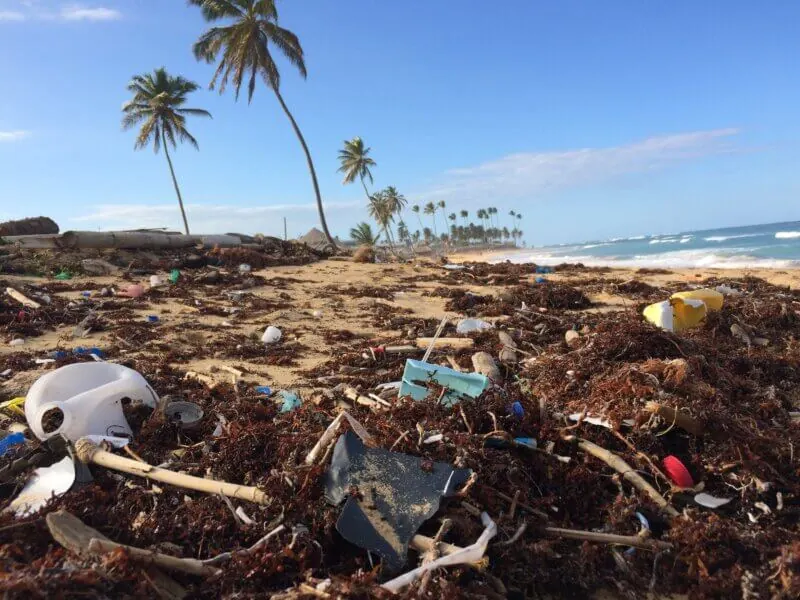New Product Launch: ClimateLens Monitor Yield Outlook - see regional and location-specific yields on key commodity crops, updated weekly.Learn More
Meredith Mejia • June 27th, 2023.
Water — the world’s largest natural resource and the foundation of life itself. Our need for water is heavily intertwined with questions about climate change, sustainability, and accessibility.
Only 3% of Earth’s water is freshwater available for drinking, and only 1/3 is accessible to us. The rest is frozen in glaciers, permafrost, or some underground structure. This has been true for all time, but our growing global population introduces concerns about water sustainability. How far are we from a water shortage, and how would we fare in case of one?
Water makes up 75% of Earth’s composition. It’s central to every living being and the complex ecosystems we depend on. Water scarcity causes the breakdown of these systems, from the bottom of the food chain all the way to our infrastructures and cities. Some parts of the globe are already feeling the world’s water crisis by way of forest fires, dying crops, and disappearing lakes, rivers, and seas.
Let’s discuss a few aspects of life that are dependent on an ample supply of water.
The quality and quantity of water significantly impact the health and sanitation of surrounding communities. Water-borne diseases like typhoid and diarrhea caused by poor water standards pose a threat to children around the globe.
According to GWSP, 2.5 billion people lack acceptable water sanitation, and 780 million don’t have access to clean drinking water. This issue is the reason for millions of children’s stunted growth and limited economic potential. Inadequate water sanitation is responsible for 88% of child deaths caused by diarrhea.
These disheartening facts shed some light on how detrimental a water scarcity crisis would be in these already-impacted regions.

Water scarcity has direct consequences on agriculture and food supply. A water shortage decreases crop yield and limits the amount of food available for distribution. Experts predict that by 2050, water scarcity will affect 50% of global grain production. Food prices will skyrocket, and food insecurity will spiral from there. For example, a 2014 California drought cost farmers $2.2 billion statewide due to crop shortages. Water availability is highly interconnected with global economies and human lives.
Many sustainable energy sources rely on hydropower – from water – to function. For example, hydropower makes up over half of Brazil’s electricity sources and 73% of Iceland’s energy! A water shortage would lead to power outages, supply chain interruptions, and transportation issues, to name a few chain reactions. This extremely efficient energy source would cease to exist without water sustainability measures being implemented and followed.
As populations grow, so does the amount of water required to support them. Communities rely on surrounding water sources for agriculture, production, and everyday needs. Water insecurity disrupts these systems, causing existing populations to suffer, emigrate, and deplete. Communities can’t thrive without sufficient access to water; water sustainability measures are critical to guarantee a decent quality of life and security.

Climate change threatens to make water scarcity a serious issue in the coming years. Many areas of the world are already experiencing record droughts that are contributing to crop shortages, forest fires, and a cycle of increased dryness. Scientists estimate that by the year 2100, water shortages in the US will culminate in an unprecedented 30-year drought. We’re expected to see a 10% decline in crop shortages over the next 25 years.
Getting a handle on water sustainability needs to be a top priority if there’s any chance of avoiding these grim predictions.
So, the question arises: when will we run out of water, and what happens when we do?
Scientists are more concerned with making sure our water supply doesn’t get irreversibly polluted. Water will be used, filtered, and returned to the world’s global water cycle until the end of time. However, mismanagement and contamination threaten to make our water supply unusable. In Mexico, climate change and resource mismanagement have already eliminated the drinking water of thousands.
With an increasing global population and climate change consequences inching closer and closer, the issue of water sustainability can no longer be avoided. The future of mankind quite literally depends on the steps we take now.
Now that we’ve answered the question, “what is water sustainability?,” we can delve into why it’s important and different ways that a water shortage could derail global life. Below are some industries that the UN classifies as heavily dependent on water.
Globally, 70% of freshwater is used for agriculture and food production. This includes watering fruit, vegetables, cattle, crop cooling, irrigation, and frost control. Feeding the world is the main source of water withdrawal, followed by industry and household use. A water shortage would lead to serious food scarcity worldwide. Farmers today use agriculture risk management tools to gain actionable insights into how the climate will affect crops.
The industry sector relies on water for material use and energy production. The paints and coating market paints a good picture of this — no pun intended. For each dollar of goods created, 123 gallons of water is used. A paint can that costs $20 would have used 2460 gallons of water to be produced.
This sheds light on how much we would have to change the way we do things given a water shortage, and how it could be beneficial to change now — before a crisis occurs.
Domestic uses account for 10% of all water use. This includes bathing, food preparation, laundry, gardening, pool maintenance, and the like. In areas like California that experience water scarcity frequently, residents are already familiar with changing day-to-day habits to save water during droughts. It’s in these areas of life that the relationship between water and sustainability really hit home.

Over half of the world’s population lives in urban areas and cities because of access to work, schools, hospitals, and other resources. The growth of urban areas is directly correlated with water use, without which these cities would be unable to thrive and grow. Because such a large portion of people live in cities, it’s crucial that access to water remains without threat. So if we wonder when will we run out of water, cities have a lot at stake.
Supply in freshwater reserves is decreasing rapidly and will continue to do so if we keep on this path. A vital way to support water sustainability is by supporting ecosystems that protect and produce fresh water. If we want future generations to have access to ample water resources, we need to help ecosystems provide the resources we so greatly depend on.
Water sustainability is under fire from an increasing population, climate change, pollution, and capitalistic business practices. At this rate, we aren’t far from a global water crisis; it’s estimated that by 2050, half of the world’s population will be experiencing water shortages. Let’s discuss some of the challenges to our water supply.
Rising temperatures are increasing the severity of weather, including droughts, floods, and severe storms. As global warming continues, we’ll see more droughts caused by higher evaporation rates, leading to more floods during the wet seasons.
Climate change is causing more than water sustainability issues; learn how researchers use climate change software to predict how extreme weather events will affect the economy.
The fact is that water is one resource we share with the rest of the world. Water use by one community has an impact on water availability in another. How and how often we use natural resources can make or break the renewability of these resource supplies. In areas where water mismanagement is rife, the question “are we running out of water?” is already a problem.
Waste of all kinds uses natural resources and contaminates them once discarded. Discussions about limiting food waste, e-waste, and single-use plastics are at the forefront of sustainability conversations. For example, how realistic is bottled water sustainability and can we continue to produce it responsibly? It seems like eliminating bottled water is inevitable for managing water resources safely.

When we contaminate water and dump it back into water sources (rivers, oceans, springs), we trash the quality of our precious resource and limit its chances of continuing to be potable. According to the UN, 80% of global wastewater is untreated. This infected wastewater runs into neighboring bodies of water, harming wildlife and infecting our drinking supply. For developing countries striving for sustainability, water management is a major hurdle.
Trees hold a massive amount of water and carbon while producing the oxygen we breathe. Deforestation, therefore, disrupts the water cycle and releases tons of carbon back into the atmosphere, further warming our planet. This contributes to droughts and water insecurity and is a main driver of the world’s water crisis.
Overfishing has already done irreversible damage to marine ecosystems. At the rate we’re going, multiple experts have predicted we will run out of seafood by 2048. This puts 60 million fishing jobs at risk and threatens food sources for billions of people. This is yet another reason why water sustainability is an issue.
Most people aren’t aware of how ocean acidification contributes to the global water crisis. As we pump co2 into the atmosphere via the burning of natural gasses, the ocean absorbs it and becomes more acidic. Not only is the ocean warming up, but acidification threatens ecosystems, especially for shelled animals that rely on calcium to create their armor.
The air and water supplies are highly interconnected; air pollution combines with evaporated water molecules and makes rain acidic, polluting freshwater and harming marine life. This kills young trees, damages paint, and contributes to water scarcity by polluting our potable water resources.
The culmination of all of these issues is contributing to the looming threat of a global water crisis.
Water is what makes our planet habitable and unique. We should all be doing our part to support water sustainability, starting at home. The following tips are ways that you can be part of the water scarcity solution while saving money in energy and utility bills at the same time.
Turning off the tap while brushing your teeth can save 8 gallons of water per day, and plugging the sink to wash dishes rather than leaving it running can save 10! These are just a few of the many water sustainability ideas you can practice at home.

Using a dishwasher instead of handwashing dishes saves a considerable amount of water. Energy-efficient and Watersense dishwashers are even better, working just as efficiently but with less water and electricity use. Make the switch and contribute to the sustainability of water today.
No matter how full the dishwasher is, it uses the same amount of water. This water sustainability idea just means waiting a few more days to complete a load.
Taking shorter showers saves water and is a small yet collective solution for the water crisis.
The EPA recommends using Energy Star and Watersense certified appliances. This includes low-flow shower heads, efficient faucets, ultra-low flush (ULF) toilets, and newer sprinkler systems. The world’s water crisis is all of our responsibility to tackle.
We understand that it’s unrealistic for everyone to stop watering their lawns. Use hoses and sprinklers sparingly – there’s no need to turn them on if it’s been raining that week. Hold off altogether during droughts and water scarcity periods.
Another solution for the water crisis is drip irrigation. It is the most efficient way to water plants; far more water-saving than regular sprinklers.
Recycled water is the reclamation of urban wastewater for environmental or industrial use. You can promote water sustainability by reusing non-potable water in your garden.
Even if we all make small changes, we still need large-scale, systematic change to find a real water scarcity solution. This looks like improved purification of water waste, protection of freshwater sources, industrial change, and municipal policy advancements. Without water sustainability, the future looks uncertain. Real change starts at the top, where the majority of resources are allocated and utilized.
Policy change is the only way to force big corporations to start operating in a more environmentally friendly way. For example, before policies placed limits, corporations could produce as much air pollution as they liked. Now, there’s a cap on air pollution and companies can actually “trade” pollution amounts based on who needs it more. A change like this, which affects the biggest polluters, is the best way to fight the world’s water crisis.

Up until recently, growth was always viewed as a positive. Now, urban planners have to weigh the risks of new developments against possible environmental degradation and resource abuse.
Using risk-based design and demand planning software, builders and municipalities can implement water sustainability and other eco-friendly practices before creating new establishments. This thoughtful planning is part of the water scarcity solution.
Understanding how water usage plays a role in development, production, and urban life is vital to creating sustainable cities. This knowledge allows officials to plan efficiently while keeping in mind potential vulnerabilities to climate events and extreme weather.
When city planners view water as an asset required for growth and economic development, they implement solutions for a water shortage in their projects.
Municipalities allocate money to preserving city-wide infrastructure, including the public water supply network. Outdated water infrastructure puts the water supply at risk, such is the example in Tampa Bay when 215 million gallons of untreated wastewater was dumped into the Gulf of Mexico due to weak containment walls. Accidents like this illustrate why officials should view natural resources as assets to be protected, and water resources management be taken seriously.
Policymakers consider the resilience of cities in terms of economy, employment, and social strength. Resilience in terms of water sustainability means the ability for communities to bounce back from catastrophe and find solutions for a water shortage if need be. Professionals use climate risk management software to plan disaster recovery, manage water resources, and ensure the growth and quality of life of inhabitants.
It’s widely known that concrete jungles create an urban heat effect and are several degrees warmer than areas with green spaces. Adding parks to cities not only gives inhabitants somewhere to enjoy nature but adds natural drainage to urban zones and reduces flood risk. This long overdue water sustainability tactic is showing extreme success as an alternative to piped drainage.

Collecting rainwater is a simple yet effective way to protect water resources and manage stormwater runoff. The water can be used to water plants, flush toilets, recharge aquifers, water lawns, and clean homes and public buildings. This is increasingly popular in cities like Los Angeles and Melbourne which have to be more drought-conscious.
Desalination is the process in which cities convert ocean water into freshwater by removing the salt content. This is a valuable process and a clever way to increase drinking water levels in coastal cities. All over the world, people are coming up with creative solutions for a water crisis like this to adapt and protect themselves.
Another solution for water scarcity is to reuse wastewater (after being properly processed) for industrial and agricultural purposes. Much of the water we drink comes from natural sources that contain processed and released water. This process is necessary for cities to replenish their water supply to meet growing needs.
One key takeaway from this is that our supply of clean, potable freshwater needs to be protected at all costs. Water quality is one of the most critical elements of urban sustainability; cities rarely prosper without access to sanitized, clean water. As we pull from our dwindling freshwater sources, long-term thinking and sustainable policy should be at the forefront of conversations. It’s easier to prevent a water crisis than to search for solutions afterward.
ClimateAi is a leading agriculture technology service provider making it possible for businesses and governments to mitigate environmental risks. Their technology is revolutionizing water sustainability and management through new systems that predict weather events and allow users to adapt and plan accordingly.
ClimateAi’s smart management science lets users get ahead of supply chain disruptions, improve crop yields, and make smarter investment decisions. Their software helps policymakers build a better water scarcity solution for the future.

Water sustainability measures build resilient communities, protecting our industry, agriculture, and homes now and in the future. As we face challenges like global warming, pollution, and a growing global population, we must keep pushing for sustainability measures to be made at the macro level. The biggest polluters must make plans to protect the environment and work toward a water scarcity solution.
ClimateAi strives to help organizations make smarter water management decisions through risk management and smart predictions. Join the movement and do your part to fight water scarcity today.